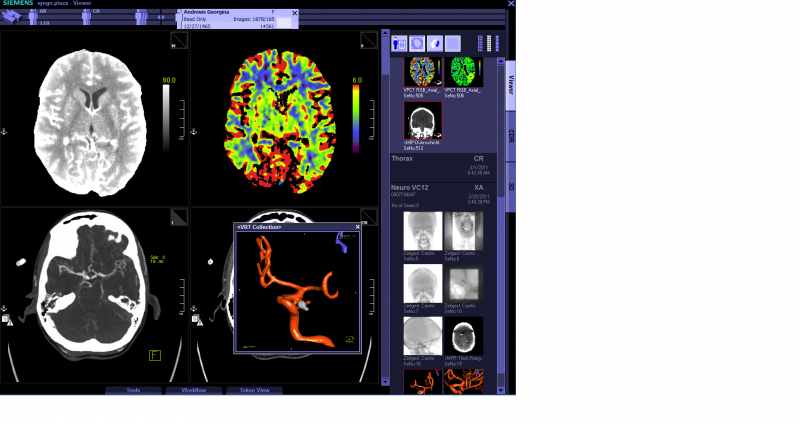
Greg Freiherr has reported on developments in radiology since 1983. He runs the consulting service, The Freiherr Group.
IT Lightens the Chains of Radiology

As radiology labors under the weight of advanced processing tools, IT developments such as the latest version of syngo.plaza promise to lighten the load. The software from Siemens pulls together applications to speed workflow.
“Man is born free and is everywhere in chains.” — Jean-Jacques Rousseau, 18th century philosopher
Not long ago images were read from lightboxes. Imaging archives were shelves upon shelves of patient jackets stuffed with films. Technologists hung images on a wall-sized alternator.
Over the last couple decades, radiologists have donned digital chains designed to improve the efficiency with which they work. The manual process of hanging films is now performed by software-driven hanging protocols and digital worklists. Workstations, once tied to CT scanners, then to CTs and MRs, have morphed into PAC systems that access multiple modalities. Dedicated workstations allow advanced processing. Workstations, PCs, tablets and smart phones extend access throughout and beyond the enterprise.
But with each step forward has come an added burden — multiple displays demanding exclusive logins — until now radiology labors under a burden of its own making. If the inefficiencies that come from using multiple technologies could be resolved, radiologists could save two and a half hours per workday, according to a GE-sponsored study conducted by ACR Image Metrix.
Recognizing the folly of cooking in too many pots, vendors are concocting brews that pour the many pots together.
GE’s Universal Viewer is one of these. It combines advanced visualization, productivity tools and multimodality workflow into a single workspace. Designed just for oncology and breast imaging, its scope argues against the “universal” in its name. But GE can be excused for its enthusiasm. The viewer makes headway against the raging conflagration of radiologic time wasters.
Designed to work with the company’s Centricity PACS and Centricity PACS-IW, Universal Viewer increases efficiency by applying machine learning algorithms, image analytics and text mining. Smart reading protocols, developed in GE’s Global Research Center, consider radiologists’ preferences on the fly as though the viewer were hanging physical film across a lightbox.
In a video, GE illustrates the capabilities of this viewer in the imaginary hands of Teri, a 40-year-old urban radiologist: http://www.youtube.com/watch?v=2J2nMpW4YqA&list=UUjPqHsHVAHsM0BUUR-Os6Jg
The viewer removes bone, analyzes blood vessels and registers data sets from different imaging exams. It integrates mammography tools, including computer-aided detection, as it interfaces with reporting systems. A zero footprint viewer delivers nondiagnostic, review-only versions of the images to clinicians spread across the enterprise.
Softek’s PatientView takes a slightly different tack than the Universal Viewer, seeking improved efficiency through the summation of diagnostic reports and key images from past exams. Working within the PACS, PatientView generates a kind of miniature electronic medical record each time the radiologist opens a case. As an application newly built into Softek’s Illuminate research engine, PatientView displays the patient’s past radiology, pathology and laboratory history automatically. If not for this software, radiologists would spend up to ten minutes collecting the information on their own, according to the company.
Siemens’ syngo.plaza saves time by pulling together applications and tools. The latest version of this software, built into syngo.via, rapidly loads the results of these applications, combining 2-D, 3-D and 4-D readings in a single place. Token View, a feature of the new software, provides a quick view of studies both on-screen and in the background, allowing syngo.plaza to serve as an interface with multiple applications.
In the way they pull radiology together, these tools provide a glimpse of the future of IT and radiology itself. Whereas in the past the development of IT products were guided by clinical needs, meeting clinical needs today depends on doing so efficiently, a challenge that is being met by reducing the weight of the chains that radiology cannot succeed without.


 December 01, 2025
December 01, 2025 









